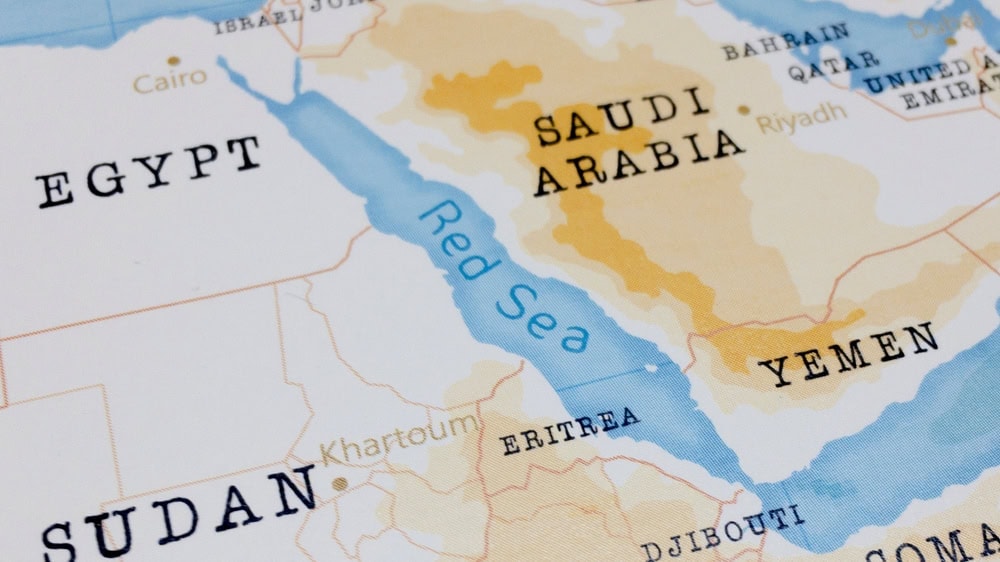
Image credit to Shutterstock
Last updated on: 15-05-2025 at 8 PM Aden Time

|
|
Cairo (South24)
Dr. Eman Zahran, a researcher at the ’South24 Center‘, said that the security scenario in the Red Sea region has witnessed dramatic changes in the first quarter of 2025, due to the escalation in the Houthi attacks and the return of US tensions with the group. According to Zahran, this has ended the period of “relative de-escalation” being witnessed following the ceasefire declaration in Gaza in January this year.
In an analysis paper published by ’South24 Center‘ on Tuesday (May 13), Eman believes that the sudden agreement between the US and the Houthis (May 6) regarding Red Sea attacks constitutes a turning point encompassing the entire regional interactions. She said the US decision to launch strikes against Houthis targets, announced by US President Donald Trump on March 15, coincided with the group's resumption of attacks against Israeli ships in the Red Sea.
Militarization of the Red Sea
According to her, the Red Sea has become a new arena for increased militarization, threatening it with unstable navigation and disrupting regional development and economic integration projects. Thus, the current security equations have to be reviewed. In this regard, the researcher identified three main indications which reflect the nature of the current threats:
The International Geopolitical Competition: Zahran emphasized that the region has increasingly become the focus of international forces seeking military positioning. She pointed to the spread of foreign bases in a country like Djibouti, which hosts American, French, and Chinese military bases. She believes that this has led to the re-emergence of the cold war circumstances in the region.
The Return of Maritime Piracy: Tensions in the Red Sea, particularly since late 2023, have led to a resurgence of pirate activity off the Somali coast, leading to a rise in maritime insurance costs and disrupting trade, amid the lack of effective international coordination.
The Failure of National States: Zahran explained that the nation states overlooking the Red Sea suffer from fragile security conditions, reflected in the activities of violent non-state actors. She noted that Yemen represents a typical case of the failure to establish a regional security system capable of deterrence and containment.
The researcher pointed out that the Houthis have adopted an escalatory strategy in the Red Sea during the first months of 2025 based on several considerations:
Israeli Attrition: By preventing Israeli ships from crossing the Red Sea along with carrying out direct strikes inside Israel, such as targeting Ben Gurion Airport (May 4) and the port of Eilat, the Houthis have used these as pressure cards to support the Palestinian cause.
Confronting Washington: Zahran noted that the Houthis are seeking to strengthen their role as part of the ’Axis of Resistance‘ by confronting US forces, particularly the aircraft carrier Harry S. Truman, in an attempt to counter the US’ designation of the group as a terrorist organization.
Internal Goals: She explained that the escalation in the Red Sea is being used internally to justify the Houthis’ military operations on Yemeni fronts such as Taiz and Marib, in an attempt to neutralize the legitimate government and achieve political and economic gains such as control over oil resources.
The researcher said that through this escalation, the Houthis have achieved several gains, including bolstering their image as a regional power independent of Iran, attracting support from the Eastern Bloc, especially Russia, and raising their stake in any future negotiations regarding Yemen.
American Calculations: The ‘Peace Through Power’ Policy
Zahran stressed that the US administration under Trump is adopting an escalatory approach toward the Houthis. This has been influenced by the "peace through strength" doctrine, seeking to restore deterrence after what was perceived as the Biden administration's failure to contain the Houthi threat.
The researcher added that Washington launched airstrikes targeting Houthi infrastructure, including missile launchers and command centers, with the aim of weakening the group and depleting its capabilities. She stressed that these moves also aimed to contain Iran’s influence, especially after the decline of Tehran's proxies in Gaza, Lebanon, and Syria.
She emphasized that these strikes were part of efforts to restore America’s influence in the Red Sea and prevent competing international powers, such as China, from imposing their economic projects, especially amid the push to take forward the ’India-Middle East-Europe Corridor’.
According to her, striking the Houthis represents the first step in a broader campaign which may in the future include the Popular Mobilization Forces (PMF) militia in Iraq, as part of a plan to curtail Iran’s influence in the region.
Possible Scenarios
Regarding future prospects, the researcher outlined two main scenarios for the development of the situation in the Red Sea:
Supporting Stability: Zahran draws a link between this path and the possibility of strengthening regional cooperation, developing collective security mechanisms, and activating multi-track diplomacy. She also called for investment in economic integration through projects such as the China-led ‘Belt and Road Initiative’ and the ‘Indian Ocean Corridor’.
Deepening Security Threats: In contrast, she warned of the continued dysfunction of the nation state and the absence of a unified Arab response. This is in light of the growing Israeli and Iranian influence and the intersection of geopolitical projects such as ’the Ben-Gurion Canal‘ and linking the port of Eilat with regional ports, which threaten to exacerbate tensions.
The researcher concluded her analysis by emphasizing the importance of reshaping the Red Sea’s regional security structure, by understanding the dynamics of new powers and developing collective deterrence tools to reduce security vulnerabilities and enhance opportunities for sustainable stability in the region.